Into the Congo
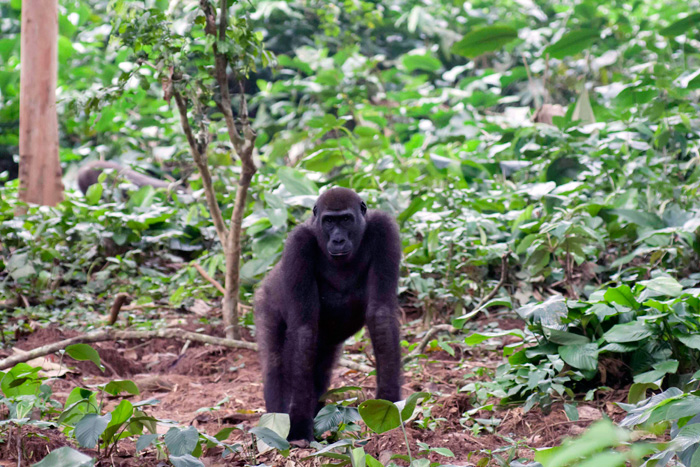
Editor’s note: Lonely Planet recently published an extraordinary collection of original tales, The Lonely Planet Travel Anthology, celebrating both the rigors and the life-changing riches of travel. The transporting story below, by former GeoEx team member Jessica Silber, is excerpted from that collection.
Forty feet beneath me, one hundred feet above me, and for a hundred-mile radius around me, the forest was bellowing. Standing on the raised camp deck, I was eye-level with the canopy of the Congo Basin. The chirps, howls, hoots, and screams that surrounded me suggested a place rich with life, but the sounds were disembodied. My eyes probed the landscape. I saw clusters of vines seize and shake; I saw leaves release from branches and float downward. But I never saw the twitch of a tail, or the flutter of wings, or the grip of the horny foot that shook them loose. This was frustrating because I was here to see. Gorillas, specifically. Six hours earlier, I had arrived in Odzala-Kokoua National Park with seven other gorilla pilgrims—all Americans who’d endured the paperwork, cost, and 24-plus hours of flying to come to the Republic of the Congo, just to experience a moment in the presence of the world’s last western lowland gorillas. In the gray haze of morning, our aircraft rolled onto a lawn that had been scooped out of the jungle specifically to welcome pilgrims like us.
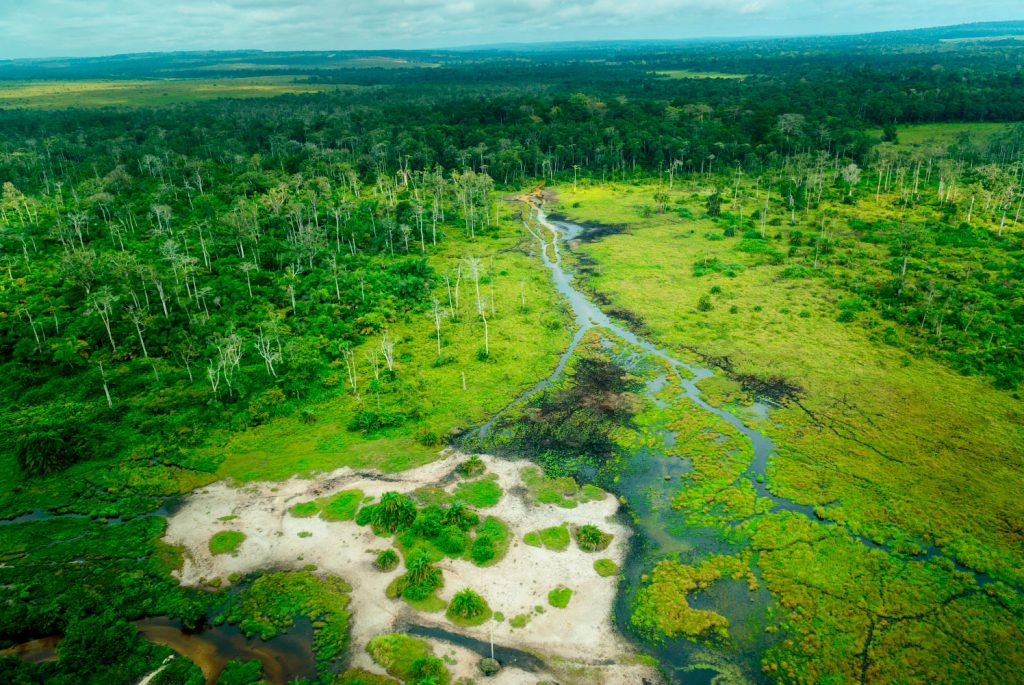
I stepped out of the fuselage and took my first look at the second-largest rain forest on earth. I saw an obscure thicket of vegetation under a heavy sky.
Three waiting men in khaki stepped forward from a fleet of Land Cruisers. Karl, in his early twenties but with sure-footed confidence, introduced himself as the head guide. We regarded him already with gratitude: Here was the leader who would guide us to the experience of our lifetimes.
But there was business to take care of first. Karl confirmed politely with a smile that there were no toilets at the airstrip, only rain forest, and that this would be the reality for miles.
Thus prodded, I and two others walked to the edge of the airstrip to take care of business. We folded ourselves, origami-like, to fit into the vegetation. Inside the breathing, heaving forest, we found ourselves completely invisible to each other but observed by hundreds of millions of spoon-billed, heavy leaves that quivered atop slender stems. I felt miles away from the women just a few feet from me.
“That is marantaceae!” Karl shouted over the engine as the Land Cruisers muscled into the jungle and spoon-billed leaves slapped against the vehicles. I’d heard the word before in reference to the family of tropical plants that dominated this forest, but the term had been unwieldy and unmeaningful to me. Now, confronted with uncountable billions of marantaceae, I understood the challenge that the researchers in Odzala faced when they first attempted to study the gorillas. Even a family of 400-pound individuals could glide away in this landscape.
At camp that night, sipping on fizzy gin and tonics with shreds of lime, we gathered for a briefing on what we were about to experience.
Gorillas are dying and their conservation has been mismanaged, Karl explained. They are unlike almost all other species on earth. They have emotions and solve problems; they comprehend some of our language; they are self-aware. Yet as the human population nears seven billion, the western lowland gorilla population plummets toward 100,000.
Those dire statistics had brought us here. Some of us had previously trekked in Rwanda or Uganda to view the mountain gorilla, a species that was—you winced to think of it—even more critically endangered than the gorillas we were about to see. They described those gorillas’ gestures and displays of comfort and affection. They described seeing wonder in the eyes of the babies. They described it as life-changing, mind-bending, activism-inspiring.
I was ready for that life-changing moment. I hoped I’d be struck with the same inspirational thunderbolt when a gorilla looked at me.
Dr. Magda Bermejo, the project’s leader and chief researcher, joined us after dinner to talk about her work as we reclined on cushions that generously sponged back the moisture of the rain forest. Straightforward and serious, she had dedicated years of research to the preservation of the western lowland gorilla. Over the course of 10 years, she and her team had worked to earn the tolerance of the area’s gorilla families. They had endured the resistance of the marantaceae and a devastating Ebola outbreak. They earned the gorillas’ trust and the community’s support, and laid the foundation of a tourism venture with a set of protocols, accommodations, infrastructure, and a purpose: Bring people here, show them the gorillas, and then send them home to evangelize their plight.
Then she said something that surprised me. “In the beginning,” she said, “when guests came, we saved the gorilla tracking for last. Not anymore. You have to go out to see them first, to calm your obsession with gorillas.”
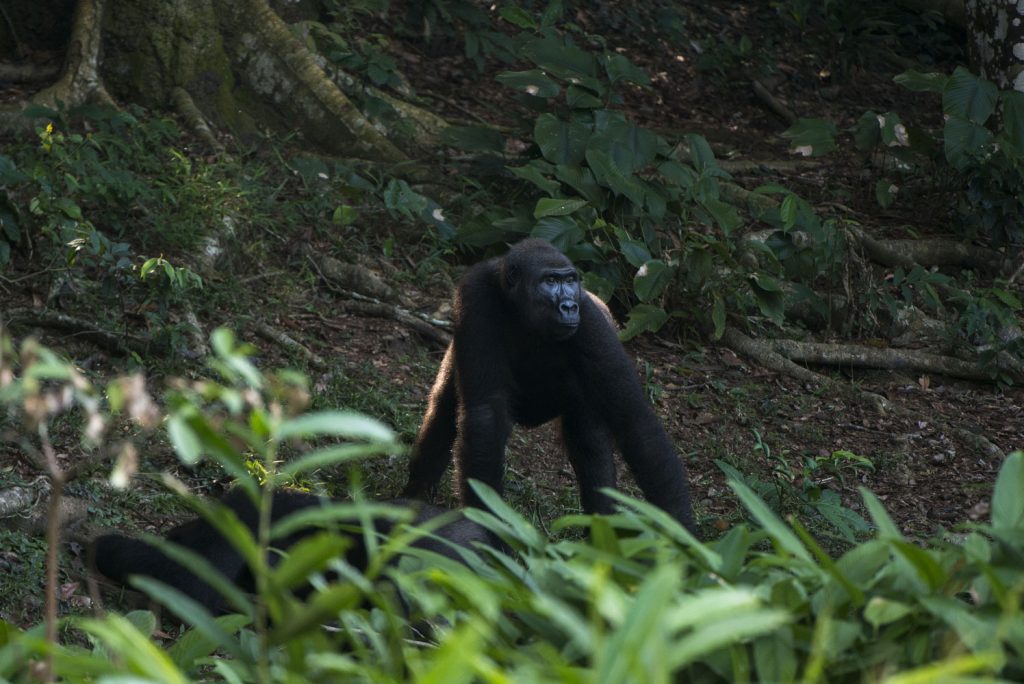
She explained that in our lust to encounter these animals, we’d fail to appreciate each part of life that sustains a gorilla: the fruit that they eat, the time of year when the trees drop the fruit, the birds that disperse the seeds of the fruit, the trees that yield twigs for the nests of the birds. “You miss the forest for the gorillas,” she scolded gently.
My eyes opened to darkness at 4:30 the next morning. Outside, a creature cried and cried, its lungs ramping up until it was all-out screaming. As the sky bruised into dawn, we gorilla pilgrims ate breakfast in silent meditation. Our minds were already with the gorillas, imagining what sharing their space would be like, wondering if the dials on our cameras were poised to the right settings.
Before we hit the trail, Karl introduced our trackers, men critical to the success of our expedition. David and Calvin had grown up just miles away. They were among the few people on earth who had mastered the language of broken twigs and decaying fruit, who could isolate the single important notes in the vast jungle orchestra. While we sipped coffee in the dark, they’d tracked the gorillas to their previous night’s nests. With this head start, they would trace the gorilla’s steps—and swings, and swaggers—through the marantaceae to wherever they were now.
Backpacks swung onto shoulders, we departed camp. Raindrops hung indecisively from the tips of marantaceae. Insects tuned their instruments.
I wasn’t sure how far or long we’d walked when we heard the first, heart-stopping bellow; I would realize later that the Congo obliterated the concepts of time and mileage, scrambling these units of measurement. David brought out a pair of garden-type shears and clipped the foliage for what seemed like years. Finally, in the dim growth, I saw a face—a gorilla, concealed by marantaceae and, by the sound we’d heard, annoyed by our approach.
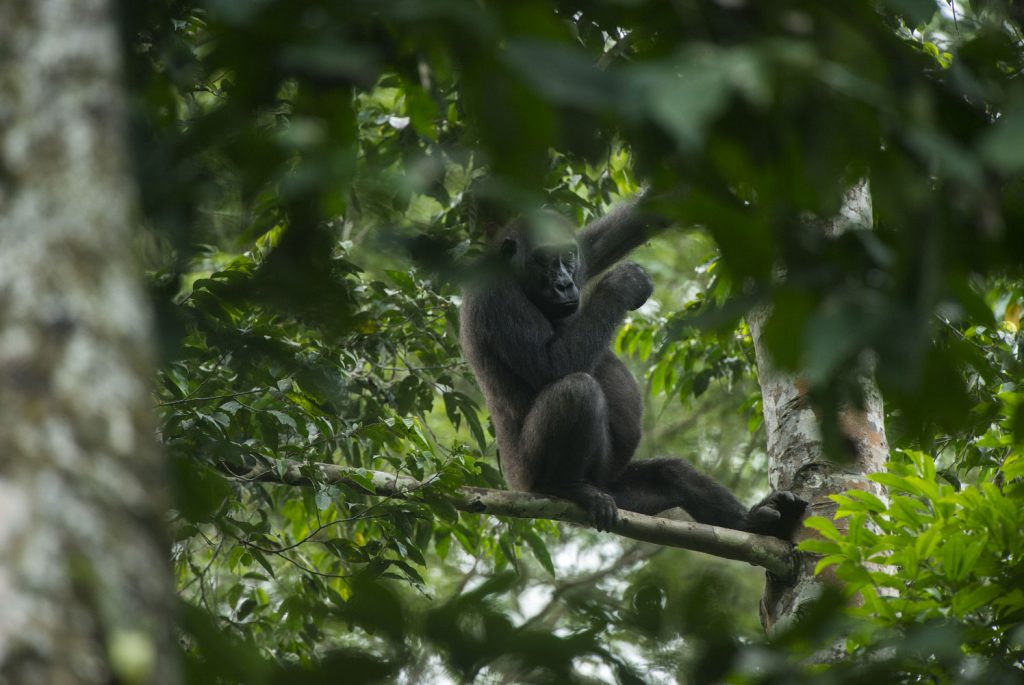
It saw me, too, and moved its head to better perceive me through the forest. He or she stood still, focused and surprised. Then, in a tree, we saw a female gorilla appraise us, touching her finger to her lips as if unsure what to do. She turned and climbed higher, her ropy limbs hooking on vines and trunks, her motions circular and fluid, regarding us over her shoulder from time to time. Time hung like a weight as we watched a whole family emerge. For the first time since we’d arrived, the forest felt silent. Our camera shutters boomed like slamming doors. All too soon, at a signal from David, we snapped our final pictures and returned to camp.
Back in camp, I sat on my deck and replayed scenes of an hour that had been planned for months but that was already in the past. I scrolled through the images on my camera. Elation was replaced by something that resembled disappointment: There was nothing there that National Geographic hadn’t already done better. No image was adequate to communicate what I’d seen. There was no new information here that would persuade the world against extinction.
I set my camera aside and tried to discern if I’d found new clarity about the state of the world. I fumbled for something inspiring to say when people asked what I’d learned. Yes, I had pictures of the gorillas. But I was increasingly sure that I hadn’t absorbed their primate wisdom.
Hours passed as I sat on the deck. Slowly, the forest seemed to habituate to me. Spiders the size of my thumb flickered up the edge of my pants. Butterflies settled on my discarded hiking boots and froze there in a sort of trance state. I accumulated ants and fallen twigs. When I stood to shake them loose, the butterflies convulsed into life, saturating the air so completely that I had to shut my mouth to avoid breathing them in whole.
“Back to reality now,” one of my fellow pilgrims had sighed as we trudged back to camp, though in fact we still had a week to spend in the rain forest. In the days following our gorilla sighting, we plunged again and again into the vibrating rain forest.
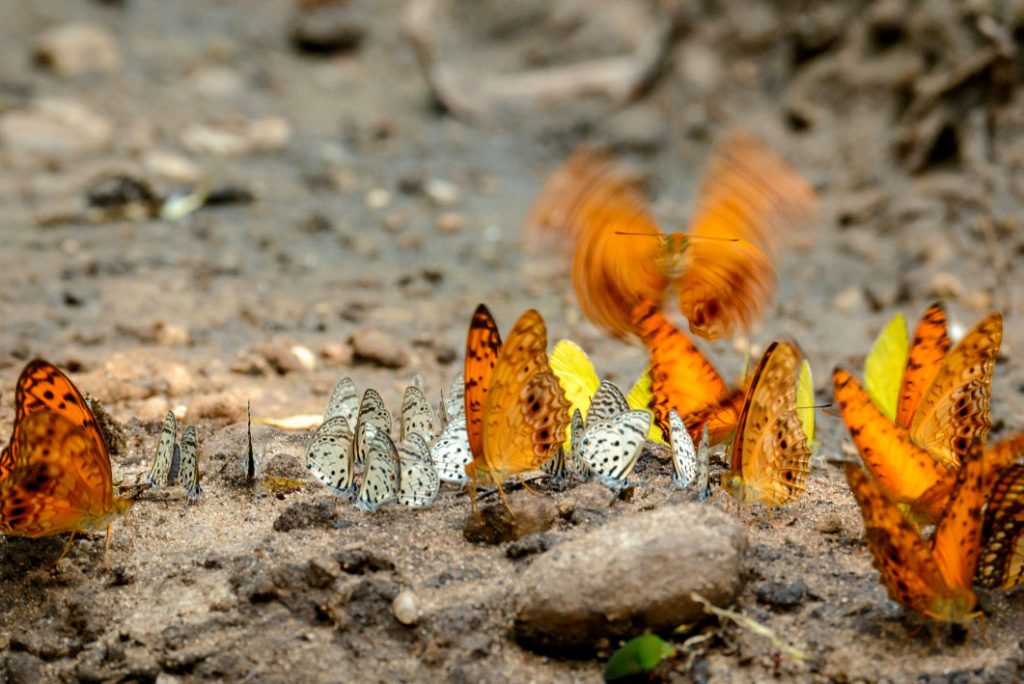
On an excursion out of camp one afternoon, Karl pointed out a brilliant jewel-pile of butterflies feasting on a heap of dung. I squatted to zoom my lens in on them. I thought of the butterflies that had exploded into the air at my tent and commented on how many there seemed to be here.
“That’s a good thing to see,” Karl said. “Butterflies are a sign of a healthy rain forest. A healthy any ecosystem, actually.”
How? A butterfly’s biological needs are so precise, their metrics for survival so small, that if you see them recurring year after year, it means the region has a stable enough climate to sustain their annual life cycle. I suddenly marveled at this cluster, a glittering still-life on a steaming pile of poop that was unaware of their role as a spokespecies for the health of the planet.
My anxiety began to ripen into awe. As the days passed, I recognized the shapes of plants beyond the dominant marantaceae. Suddenly, no two leaves appeared the same—as though each plant had been confronted with the same question of survival but had come up with a different answer. I came across a species that curls its leaves when touched, and we took turns stroking our fingers down its stem, causing it to shiver and retract. Each time we passed this plant, I paused to tickle it, engaging in a fresh dialogue with the forest that started when the obsession with gorillas ended.
One afternoon, as I trailed behind the group, a flicker of movement on the ground beckoned to me. I stepped closer. It was a scene of carnage: an army of ants overtaking a grasshopper. The grasshopper thrashed pitifully. The ants were improbably huge as if each segment of their bodies was magnified 100 times, and they were relentless.
I felt a screaming pressure on my calf. My eyes dropped and zoomed to see renegade ants seizing my boots, my socks, the hem of my pants. Sweat formed immediately as ants used their jaws to pick-axe up my legs. A member of our group noticed my panic and shielded me as I tore at my clothes, dislodged the last of the ants and composed myself, but I spent the afternoon slapping intruding hairs away from my face or startling at the unseemly lunge of a marantaceae leaf.
The Congo was a full-body experience, I thought the next day as I stepped carefully over a hissing rope of ants that bisected our trail. It was impossible to appreciate with sight alone. We had come to see gorillas, but for the rest of the trip, we could not rely on our eyes to give us the returns we expected. Rarely did an animal expose itself. Rather, a noise or track would make us twist and contort just in time to see the whip of a disappearing tail or the flash of an iridescent feather.
But instead of disappointment, I felt breathless elation as again and again, we experienced meaningful encounters from suggestions of a presence. Karl saw the knuckle-drag of a chimpanzee and his eyes widened as he appealed to us to consider the possibility of our sharing the same space with wild chimps that might never have come into contact with humanity before. As I considered this, I felt a thrill that I had never experienced from staring at something and clicking a shutter.
Here was the V-shaped footprint of a Congo clawless otter. A tree that evolved without bark so it wouldn’t be engulfed by strangler figs. A skyscraper of spider webs, built communally, where all spider residents split the spoils that fluttered in. Humans could also eat the web in an emergency situation, we learned, if they were inclined to boil it into a foul-tasting stew.
One morning, we waded across a shimmering bai, a salt marsh rich with minerals, into the jungle. As we neared the edge of the forest, hundreds of green pigeons rose from the trees in a tremendous exhalation. As we stepped into the jungle, smells crawled up my nostrils: rotten and sweet, vegetative and fresh, sticking to my face and clothes.
Suddenly, the bush near us spasmed. At the front of our cortege, Karl’s whisper had all the urgency of a scream: “Bongos!”
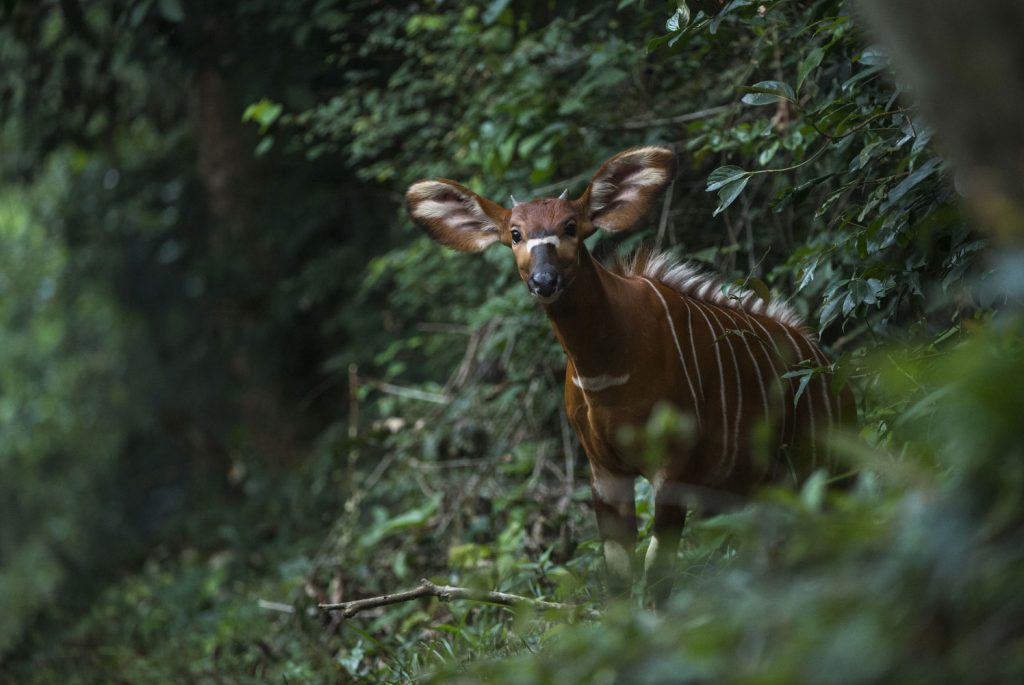
We moved clumsily toward the source, hearts pounding, then caught our breaths and squatted to glare through the lower stories of vegetation for a sign of the elusive antelope. But it was our ears that had to re-awaken, to step out of their supporting role to the eyes, and provide information. How many footsteps were those? How large was the animal? What direction was it going? What the hell was it?
There was the flash of a red rump, less impressive than the thunder of its sound. In the quiet of the bongos’ retreat, a hornbill flew overhead with such gusto that its wings sounded like propellers.
Perhaps to distract us from the disappearing bongos, Karl began to explain how hornbills effectively disperse seeds in the rain forest. The birds’ guts go easy on seeds, and their flight range is impressive, spreading the seeds a generous distance from the parent tree. No one had probably ever visited the Congo just to see a hornbill, I thought, a scruffy bird that looked as though someone had welded two beaks onto its face. Yet the Congo existed partially because of the work of these birds.
As we emerged from swampy forest into dry savannah, nearly at the end of our walk, the forest emitted a loud wail to my left. I kept walking, assuming this was another yowl of a bird. But Karl gasped. “That is a chimpanzee!”
Our heads whipped to the side, and yes, could it be?—there was a black form moving in the branches of the distant trees. Our hands flew to binoculars and cameras. Karl herded us into a semicircle, chattering with unconcealed excitement. “This is unbelievable! I cannot believe this! They have not even moved at the sight of us! This is incredible. Incredible! I have to say this could very well be the first time they have seen humans. Yes, this is very possible, even probable.”
Wild chimpanzees, unaccustomed to any human presence—how many creatures left on earth could share that distinction? Chimps were even more skittish than gorillas, and it had taken years for Dr. Bermejo to get the gorillas to tolerate her. Travelers wouldn’t come to the Congo with a hope of seeing a chimpanzee. A gorilla was a more reliable draw.
A deep mechanical rumble jerked my eyes away from the chimps to see the supply plane ascending from the nearby airstrip. When I turned back, the chimps had melted away. No one had managed to take a decent photo; no long lens would ever be long enough. I would have to be content with the memory of that first long wail, the wobbly mental image of their long dark bodies.
Still, we were exhilarated. We replayed the scene as we returned to camp in a Land Cruiser, revisited by the same enthusiasm we’d had for the gorillas. Night fluttered down on us, and ahead of the vehicle, two pennant-winged nightjars fireworked into the air, long feathers like a trail of smoke.
I thought back to what Dr. Bermejo had said about our obsession with gorillas. Was it because we saw gorillas as extensions of ourselves? Was it because we believed that if every person came face to face with a gorilla and recognized him or herself, we would elevate their status to something that requires our urgent and personal care? But then again, I thought, people came face to face with gorillas all the time in zoos. There was something about the forest that activated their magic.
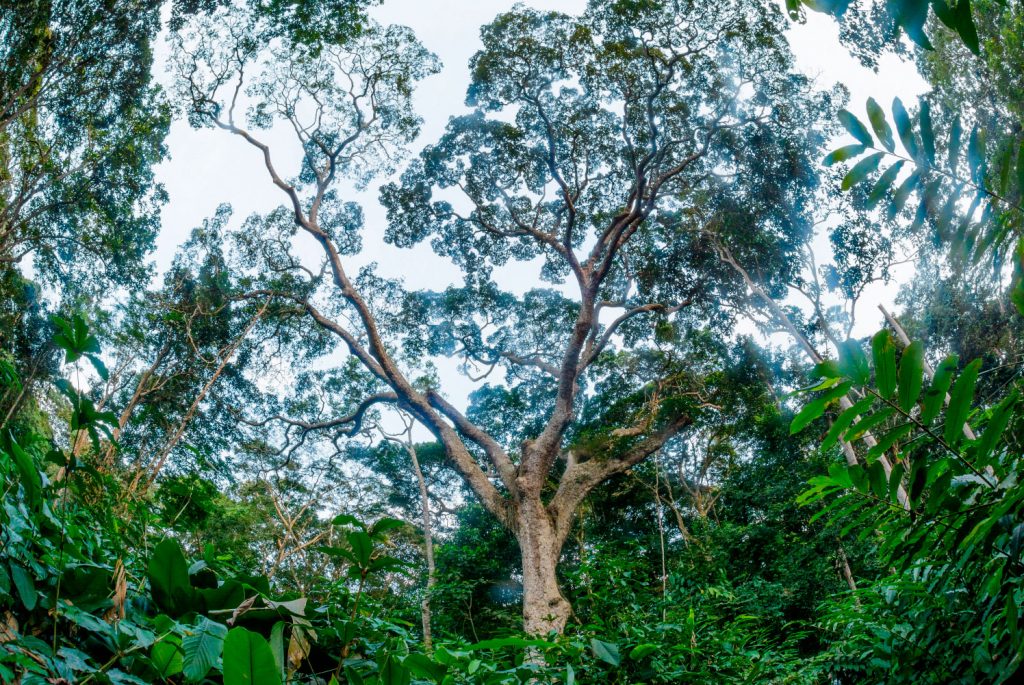
As humans, we don’t see the forest as an extension of ourselves. But it began to dawn on me then that we, like the gorillas, were extensions of it. Being in its midst, I had the impression that if you leaned on a tree for just one cosmic moment, your hand might sprout into the trunk and you would coil up it for energetic miles until you burst into the canopy, gasping for light. That if you let a bare toe linger too long into the mud, your humanity would dissolve and you’d sweep up into the circulation of the rain forest. All of your cells would shoot up into the tree trunks and convert from matter into sugar and drop down to the ground as big fruit that burst open with rot, to be dismantled and carried off by ants as morsels and molecules that were once your hair and eyelashes and fingernails.
As I approached my final moments in the Congo, it was the entire ecosystem that had kneaded me into awe and delight.
On one of our last nights in camp, we embarked on a night walk. Equipped with headlamps and torches, we stepped into the screeching bush, shining lamps onto millipedes, watching for flashing eyes, listening to bats lunge at the bloated fruit of strangler figs.
Karl asked us to turn out all of the lamps, to absorb the sounds of this new environment. The lights blinked out and the hoots and howls seemed to crescendo in my ears.
I thought of that first day as I stood on my deck, straining to see, frustrated by the invisible source of the sounds. I thought about the work of the hornbills and the shyness of the chimps and the sense of hope that a group of butterflies can bestow. I thought about Dr. Bermejo’s appeal to see the gorillas, to feel moved by them, but to strain to appreciate everything else, even if it required more effort.
In the darkness, I closed my eyes and listened.
* * * * *
Reproduced with permission from The Lonely Planet Travel Anthology, published by Lonely Planet, © 2016 Lonely Planet.
To learn more about gorilla trekking, call one of our experts at 888-570-7108.
This beautifully descriptive article took me back to my own trips into rain forest and jungle to see mountain gorilla, but it’s the magic of the forest that stays with you. The sounds, the insects, the ants, an army of red ants trooped through my cabin at Bwindi in the middle of the night. Two hours later the last stragglers were hurrying to catch up. I can’t wait to return.
I absolutley loved reading that. Thank you. I was privilaged to visit the Amazon in Equador 2 years ago and your description reminded me of that living, seething, rainforest that felt very much like it might engulf my humanity if I were to stray or linger on the path. It too was an incredible experience that became more about the jungle than the chance to spot an elusive jaguar. We didn’t see one but saw so many other amazing creatures, insects, plants, snakes, fish. Thanks for taking me somewhere new and back into the Amzon Jungle.
Thank you for sharing your experience.
Loved “but I spent the afternoon slapping intruding hairs from my face”
I saw my gorillas in Rwanda 18 months ago and with our amazing guides were able to observe them for almost an hour watching quietly from just 6 feet away. The leader was on his side resting while the females groomed him. Amazing also saw a baby and a pregnant female. He tolerated us as long as we sat and assumed a submissive stance
Wonderful info. I did a trip to Africa about 3? years ago. Safaris in Rwanda, Uganda, Kenya and Tanzania. Had ‘done’ Madagascar before.
Have been very fortunate to travel to a GOOD MANY countries. Such as cycling Vietnam, the U.S., England and Wales. Scuba diving world-wide.
Life has been good.
Fabulous article, Jess. Could feel the life coursing through your words.

